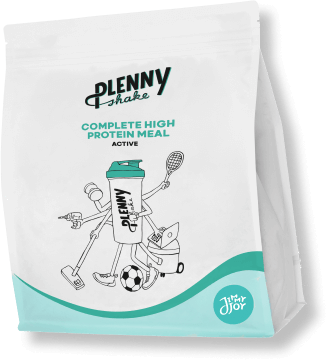 Plenny Drink is an easy and nutritionally complete vegan meal that contains a balanced macro split (high in protein, a source of fiber, low in sugar and salt). It also contains all 26 essential vitamins and minerals your body needs to stay healthy.
Plenny Drink is an easy and nutritionally complete vegan meal that contains a balanced macro split (high in protein, a source of fiber, low in sugar and salt). It also contains all 26 essential vitamins and minerals your body needs to stay healthy.
The only preparation needed is to shake and enjoy! The Plenny Drink comes in the flavors Vanilla and Chocolate and provides you with 400 calories: 20% protein, 32.6% fat, 44,5% carbohydrates and 3% fibers. Are you getting interested already?
This article will tell you all about Plenny Drink and the nutrients it contains!
Ingredients
- Water
- Soy protein isolate
- Oats
- Maltodextrin
- Modified starch (tapioca starch)
- Rapeseed oil
- Oat fiber
- Emulsifier: Soy Lecithin
- Thickener: Microcrystalline cellulose, Carboxymethylcellulose, Guar gum
- Acidity regulator: Citric Acid
- vitamin & mineralmix
- Aroma
- Flavouring: Vanilla seeds / Cacao powder
- Sweetener: sucralose
Protein
Proteins are the building-block of essential compounds in your body, such as hormones and enzymes, and give your body its structure (1,2). Since we cannot go without this nutrient, we solved this problem for you by making the Plenny Drink high in protein. A minimum of 0.8 gram of protein per kg of body weight per day is recommended, with an additional 30% for vegan diets (1,3). Plenny Drink provides you with 20 grams of protein per portion in the correct amino-acid ratio, being even suitable for the more active people amongst us. The main protein source in the product is soy protein, providing you with the following amino-acid profile:
Per portion (330 ml)
|
Alanine |
0,86 g |
|
Arginine |
1,52 g |
|
Aspartic acid |
2,31 g |
|
Cysteine |
0,26 g |
|
Glutamic acid |
3,80 g |
|
Glycine |
0,83 g |
|
Histidine |
0,53 g |
|
Isoleucine |
0,99 g |
|
Leucine |
1,62 g |
|
Lysine |
1,25 g |
|
Methionine |
0,26 g |
|
Phenylalanine |
1,06 g |
|
Proline |
1,02 g |
|
Serine |
1,06 g |
|
Threonine |
0,76 g |
|
Tryptophan |
0,26 g |
|
Tyrosine |
0,76 g |
|
Valine |
0,99 g |
Fats
Fats are an important nutrient, mostly known for protecting you from the cold in the winter and creating those love handles you can’t seem to get rid of. But fat has an even bigger and more positive role in your body, such as being building-blocks of your cells and it makes your brain and muscles function well (4,5) . When you want to benefit from the pro’s rather than the cons of this nutrient, two things need to be taken into account; the amounts and the sources.
The fat content in the Plenny Drink contributes to 32.6% of its total energy, which is right in the middle of the 20-40 E% recommended (6,7). Oats and soy provide a bit of fat in the Plenny Drink, but the main source is rapeseed oil, which contributes to good health. How so? Rapeseed oil has a low saturated fatty acid content. Saturated fatty acids (SFAs) are linked to high cholesterol and blockages in arteries, and should therefore be as low as 10% of the total energy intake (7). Adding rapeseed oil in the Plenny Drink makes sure the amount of SFAs is not higher than 2 E%. But there is more! Rapeseed oil has an excellent ratio between α-linolenic acid (ALA) and linoleic acid content (LA). These beneficial polyunsaturated fats (PUFs), better known as omega 3 and -6 fatty acids, are linked to the prevention of heart diseases and strokes. Sadly, your body can’t make them, making them essential in your diet in the amounts of 6 to 11 % of your total energy intake (5,7).
So how much omega fatty acids are present in a bottle of Plenny Drink?
|
Fatty acid |
g per bottle |
Percentage of total energy |
|
Alpha-linolenic acid (omega 3) Linolenic acid (omega 6) |
0,8 g 2,2 g |
3,0 % 8,2 % |
WHO stated “The minimum intake levels for essential fatty acids to prevent deficiency symptoms are estimated at a convincing level to be 2,5%E LA plus 0,5%E ALA” (7). As you can see, the amounts provided by the Plenny Drink make sure you don’t have to worry about that.
Carbohydrates
Carbohydrates are a nutrient that can be split up in categories such as sugars and starches, both providing your body with glucose. Glucose is the main energy source for the brain, and therefore essential in your diet (8). A required daily intake of 130 gram per day for adults has been established by The Institute of Medicine (IOM), to provide the brain with this fuel (9). Plenny Drink contains 44,6 gram of carbohydrates per meal, which makes a diet solely based on this product provide you with the sufficient amount of this nutrient.
After digestion, carbohydrates make your blood-sugar rise. A tool to measure this blood-sugar response is the glycemic index, being high with carbohydrates that are easy to digest, and lower with the more complicated-ones (10). Plenny Drink provides you with the perfect combination of these sources, being maltodextrin, tapioca starch (modified starch), and oats. Why this combination? Maltodextrin is easy to digest and therefore a fast source of energy for your brain (11). The complementary carbohydrate sources tapioca starch and oats have been added to make sure your blood-sugar does not go sky high. Tapioca starch is a resistant starch, meaning it is harder to digest. This results in a lowering effect on the glycemic index and making you feel more fulfilled after a meal (12). This increased satiety is also thanks to the oats, being rich in the fiber beta-glucan, which slows down your digestion (13).
And what about sugar? A diet solely based on Plenny Drink contributes to a sugar content of 7% of the total energy intake, being below the upper limit of 10E% of sugar. This upper-limit is strongly recommended by WHO for a healthy diet (14).
Fibers
To smoothen your digestive system, some extra fibers have been added to the Plenny Drink in the amounts of 5,9 grams per portion. This amount is based on recommendations by authorities such as the Dutch Health Council and the American Heart Association, defining 30-40 grams of fiber per day or 25 grams of fiber in a 2.000 calorie diet (15,16). The Plenny Drink contains 30 grams of fibers over 2.000 calories, making it easy for you to tick that box!
Micronutrients
We also provided you with the perfect amounts of micronutrients, including vitamins and minerals. Small but mighty! Micronutrients play a role in the well-functioning of your nervous system, blood circulation and immune system. A deficiency of these nutrients is therefore linked to an increased chance of disease (17). But no worries, we got your back! The amount of micronutrients added to the Plenny makes sure that you consume at least 100% of the daily reference intake of an average adult when your diet is completely based on Plenny Drink (18).
Besides the nutritional advantages of Plenny Drink, they get their tastiness from the natural cacao powder and vanilla seed we add! Can’t wait to try them out? Make your order here.
|
Vitamins-Minerals per |
330 ml*** |
RI |
|
|
Calcium |
185 |
mg |
23%* |
|
Phosphorus |
140 |
mg |
20%* |
|
Magnesium |
75 |
mg |
20%* |
|
Potassium |
400 |
mg |
20%* |
|
Chloride |
160 |
mg |
20%* |
|
Iron, total |
3,2 |
mg |
23%* |
|
Zinc |
2,0 |
mg |
20%* |
|
Copper |
0,2 |
mg |
20%* |
|
Manganese |
0,4 |
mg |
20%* |
|
Selenium |
11 |
μg |
20%* |
|
Chromium |
8 |
μg |
20%* |
|
Molybdenum |
13 |
μg |
26%* |
|
Iodide |
30 |
μg |
20%* |
|
Vitamin A |
160 |
μg |
20%* |
|
Vitamin D |
3,0 |
μg |
60%* |
|
Vitamin E |
2,4 |
mg |
20%* |
|
Vitamin C |
40 |
mg |
50%* |
|
Vitamin K |
16 |
μg |
21%* |
|
Thiamin |
0,2 |
mg |
20%* |
|
Riboflavin |
0,3 |
mg |
23%* |
|
Niacin |
3,6 |
mg |
23%* |
|
Vitamin B6 |
0,3 |
mg |
22%* |
|
Folic acid |
60 |
μg |
30%* |
|
Vitamin B12 |
28 |
μg |
1120%* |
|
Biotin |
10 |
μg |
20%* |
|
Pantothenic acid |
1,2 |
mg |
20%* |
* % of the daily reference intake for vitamins and minerals
** Reference intake of an average adult (8400 kJ/2000 kcal)
*** 1 serving = 330 ml
Sources
- WHO | Protein and amino acid requirements in human nutrition [Internet]. WHO. World Health Organization; [cited 2020 Apr 7]. Available from: http://www.who.int/nutrition/publications/nutrientrequirements/WHO_TRS_935/en/
- Pendick D. How much protein do you need every day? [Internet]. Harvard Health Blog. 2015 [cited 2020 Apr 9]. Available from: https://www.health.harvard.edu/blog/how-much-protein-do-you-need-every-day-201506188096
- Waarom hebben vegetariërs en veganisten meer eiwit nodig? | Voedingscentrum [Internet]. [cited 2020 Apr 7]. Available from: https://www.voedingscentrum.nl/nl/service/vraag-en-antwoord/gezonde-voeding-en-voedingsstoffen/waarom-hebben-vegetariers-en-veganisten-meer-eiwit-nodig-.aspx?query=eiwitten
- Boston 677 Huntington Avenue, Ma 02115 +1495‑1000. Types of Fat [Internet]. The Nutrition Source. 2014 [cited 2020 Apr 9]. Available from: https://www.hsph.harvard.edu/nutritionsource/what-should-you-eat/fats-and-cholesterol/types-of-fat/
- Publishing HH. The truth about fats: the good, the bad, and the in-between [Internet]. Harvard Health. [cited 2020 Apr 9]. Available from: https://www.health.harvard.edu/staying-healthy/the-truth-about-fats-bad-and-good
- Vetten | Voedingscentrum [Internet]. [cited 2020 Feb 19]. Available from: https://www.voedingscentrum.nl/encyclopedie/vetten.aspx
- WHO | Fats and fatty acids in human nutrition [Internet]. WHO. World Health Organization; [cited 2020 Apr 7]. Available from: https://www.who.int/nutrition/publications/nutrientrequirements/fatsandfattyacids_humannutrition/en/
- Slavin J, Carlson J. Carbohydrates1. Adv Nutr. 2014 Nov 3;5(6):760–1.
- Medicine I of. Dietary Reference Intakes for Energy, Carbohydrate, Fiber, Fat, Fatty Acids, Cholesterol, Protein, and Amino Acids [Internet]. 2002 [cited 2020 Apr 9]. Available from: https://www.nap.edu/catalog/10490/dietary-reference-intakes-for-energy-carbohydrate-fiber-fat-fatty-acids-cholesterol-protein-and-amino-acids
- Publishing HH. A good guide to good carbs: The glycemic index [Internet]. Harvard Health. [cited 2020 Apr 9]. Available from: https://www.health.harvard.edu/healthbeat/a-good-guide-to-good-carbs-the-glycemic-index
- Hofman DL, van Buul VJ, Brouns FJPH. Nutrition, Health, and Regulatory Aspects of Digestible Maltodextrins. Crit Rev Food Sci Nutr. 2016 Sep 9;56(12):2091–100.
- Ask the Expert: Legumes and Resistant Starch [Internet]. The Nutrition Source. 2015 [cited 2020 Apr 9]. Available from: https://www.hsph.harvard.edu/nutritionsource/2015/11/16/ask-the-expert-legumes-and-resistant-starch/
- Oats | The Nutrition Source | Harvard T.H. Chan School of Public Health [Internet]. [cited 2020 Apr 9]. Available from: https://www.hsph.harvard.edu/nutritionsource/food-features/oats/
- Guideline: sugars intake for adults and children [Internet]. [cited 2020 Apr 9]. Available from: https://www.who.int/publications-detail/9789241549028
- Whole Grains, Refined Grains, and Dietary Fiber | American Heart Association [Internet]. [cited 2020 Apr 9]. Available from: https://www.heart.org/en/healthy-living/healthy-eating/eat-smart/nutrition-basics/whole-grains-refined-grains-and-dietary-fiber#.WVVm4RMrIdU
- Kromhout D, Spaaij CJK, de Goede J, Weggemans RM. The 2015 Dutch food-based dietary guidelines. Eur J Clin Nutr. 2016 Aug;70(8):869–78.
- Publishing HH. Micronutrients have major impact on health [Internet]. Harvard Health. [cited 2020 Apr 9]. Available from: https://www.health.harvard.edu/staying-healthy/micronutrients-have-major-impact-on-health
- Council of the European Union. on the provision of food information to consumers [Internet]. EU: European Parliament; 2011 [cited 2020 Apr 9]. Available from: https://eur-lex.europa.eu/legal-content/EN/TXT/HTML/?uri=CELEX:32011R1169&from=EN
 Everything You Need In One Meal
Everything You Need In One Meal
 Stay Full For 3-5 Hours
Stay Full For 3-5 Hours













 Product added to cart
Product added to cart





